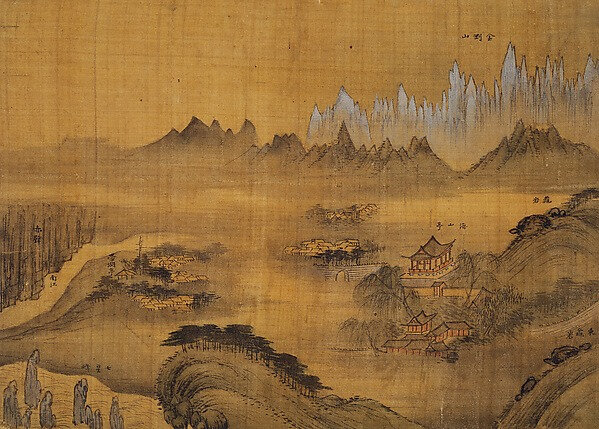Album of Mount Geumgang (Pungak-docheop) by Jeong Seon, 1711
Jeong Seon painted this album following his first trip to the Diamond Mountains. He likely traveled northeast from the capital, Hanyang (today’s Seoul), and traversed the mountain range from Inner to Outer Geumgang toward the sea. Displayed here are six scenes from a total of thirteen (the last leaf in the album is a colophon). The varied compositions reveal Jeong’s early experimentations, which he would repeat, adapt, or refine over the course of his career.
Jeong Seon (artist name: Gyeomjae) (Korean, 1676–1759), General View of Inner Geumgang, from Album of Mount Geumgang (Pungak-docheop), 1711, Joseon dynasty (1392–1910). Six leaves from a fourteen-leaf album; ink and light color on silk, 14 1/4 × 14 7/8 in. (36.2 × 37.8 cm) © National Museum of Korea
This overview format as well as the juxtaposition of dark, foliage-covered rolling peaks and the white spiky pillars reveal Jeong’s ingenuity. Prominent sites enfolded into this view include Jangan Temple and the adjacent stone bridge in the foreground center and the tallest summit, Biro Peak, in the far distance. Labeling important sites is a convention Jeong applied to many of his paintings of the Diamond Mountains, which other artists followed.
Jeong Seon (artist name: Gyeomjae) (Korean, 1676–1759), Mount Geumgang Viewed from Danbal Ridge, from Album of Mount Geumgang (Pungak-docheop), 1711, Joseon dynasty (1392–1910). Six leaves from a fourteen-leaf album; ink and light color on silk, 14 1/8 × 14 5/8 in. (35.9 × 37.1 cm) © National Museum of Korea
Travelers to the Diamond Mountains usually approached from the Danbal Ridge, from where they would catch their first glimpse of the glittering rocky peaks—depicted here as if floating in the sky, creating a sense of drama and wondrous discovery. Jeong employed multiple perspectives to create this view.
Jeong Seon (artist name: Gyeomjae) (Korean, 1676–1759), Buljeongdae Rock, from Album of Mount Geumgang (Pungak-docheop), 1711, Joseon dynasty (1392–1910). Six leaves from a fourteen-leaf album; ink and light color on silk, 14 1/4 × 14 7/8 in. (36.2 × 37.8 cm) © National Museum of Korea
This haunting scene beautifully captures the main rock in the center (with a cluster of pine trees atop) surrounded by stunning and ghostly white pillars floating behind. This site is one among many celebrated markers within Inner Geumgang.
Jeong Seon (artist name: Gyeomjae) (Korean, 1676–1759), Baekcheon Bridge, from Album of Mount Geumgang (Pungak-docheop), 1711, Joseon dynasty (1392–1910). Six leaves from a fourteen-leaf album; ink and light color on silk, 14 5/8 × 13 1/2 in. (37.1 × 34.3 cm) © National Museum of Korea
The Baekcheon Bridge, which is not visible in this scene, straddles the transition from Inner to Outer Geumgang, the eastern part of the Diamond Mountains. The delightful close-up scenery focuses as much on the travelers as the landscape, and reveals the changing modes of their transportation: from sedan chairs, as seen on the left of the stream, to horses, on the right.
Jeong Seon (artist name: Gyeomjae) (Korean, 1676–1759), Haesan Pavilion, from Album of Mount Geumgang (Pungak-docheop), 1711, Joseon dynasty (1392–1910). Six leaves from a fourteen-leaf album; ink and light color on silk, 10 5/8 × 14 3/4 in. (27 × 37.5 cm) © National Museum of Korea
Unlike the previous two scenes, this leaf depicts a relatively large swath of the mountains, in an overhead composition. With the white rocky peaks in the background, a wide slice of Sea Geumgang is presented—from the Haesan Pavilion in the middle ground to the Seven Star Pillars, a constellation of oddly shaped rocks, in the sea on the lower left corner.
Jeong Seon (artist name: Gyeomjae) (Korean, 1676–1759), Chongseok Pavilion, from Album of Mount Geumgang (Pungak-docheop), 1711, Joseon dynasty (1392–1910). Six leaves from a fourteen-leaf album; ink and light color on silk, 14 7/8 × 14 3/4 in. (37.8 × 37.5 cm) © National Museum of Korea
Among the most striking sceneries of the Diamond Mountains are the basalt formations rising out of the sea along the eastern coast of the peninsula. The pavilion on the cliff shares the center stage in this composition, while the surrounding water occupies more than half the space. In later depictions, Jeong often placed greater focus on the fantastical rocks.

/https%3A%2F%2Fprofilepics.canalblog.com%2Fprofilepics%2F1%2F0%2F100183.jpg)
/https%3A%2F%2Fstorage.canalblog.com%2F03%2F02%2F119589%2F96711876_o.jpg)
/https%3A%2F%2Fstorage.canalblog.com%2F11%2F31%2F119589%2F94773502_o.jpg)
/https%3A%2F%2Fstorage.canalblog.com%2F20%2F83%2F119589%2F94772815_o.jpg)
/https%3A%2F%2Fstorage.canalblog.com%2F26%2F72%2F119589%2F75604929_o.jpg)
/https%3A%2F%2Fstorage.canalblog.com%2F59%2F60%2F119589%2F26458628_o.jpg)








/http%3A%2F%2Fstorage.canalblog.com%2F79%2F00%2F119589%2F111596346_o.jpg)
/image%2F1371349%2F20240425%2Fob_c453b7_439605604-1657274835042529-47869416345.jpg)
/image%2F1371349%2F20240425%2Fob_59c6f0_440358655-1657722021664477-71089985267.jpg)
/image%2F1371349%2F20240425%2Fob_07a28e_440353390-1657720444997968-29046181244.jpg)